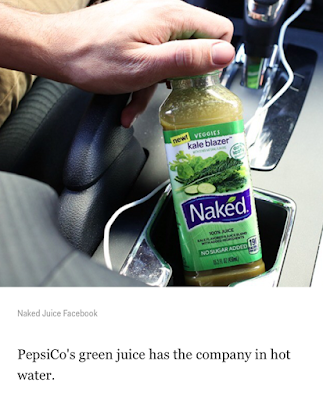You know how you weave through the aisles during lunch hour
looking for the 'healthiest' option? Well, sometimes, what you think is 'healthy'
is really just hell-worthy (not exactly the best pun, but you know what I mean).
So, Pepsi has just been sued (not the first time) for making
their juices seem healthier than they are. Those “naked” juices, marketed to be
“healthy,” are packed with more sugars than if you drank a can of Pepsi/Coke.
Imagine that.
 |
| http://www.businessinsider.com/pepsico-sued-for-naked-juice-marketing-2016-10 |
I am not surprised. I have a rule of thumb: I barely do liquid
calories that I didn’t prepare myself. I did a blog post on juices a while back
and many of my readers had been substituting fizz for juices in the hopes that
the juices were healthier. Now, whilst the juices may have a ton more vitamin
C, antioxidants and the like, you are better off buying your own fruit than
purchasing a blended mix from the shelf.
Here are some tips for buying calories marketed to be
‘healthier’ if you are seeking weight loss and are on a ‘diet’*. You probably
know by now that I am all about a portion-controlled diet as opposed to a
calorie-focused diet.
- When buying items that say “healthy,” take a closer look. Often times, ‘healthy’ items proclaim to have less fat that the unhealthy items and compensate less fat for more sugar. In other instances, the “low sodium” items are just diluted with water – you’re better off buying regular soy sauce and using a little, than wasting your resources on low sodium soy sauce. Also, low fat muffins often contain more sugar than full-fat muffins. Plus, if you’re gonna eat a muffin, please eat a damn muffin and enjoy it – or eat half a muffin.
- When buying “lower calorie” items, read the label.
a. Example
#1: Amstel Malta markets on the premise that it has lower sugars than other
brands. Have you looked at the difference between the sugars in it and the
sugars in Maltina? Give or take, there is about a 0.2g difference in sugars –
which really is negligible. Also, there's barely a 20-calorie difference between Amstel and Maltina, which is way too marginal to be considered "healthier."
b. Example
# 2: My friend bought “Light Almond Milk,” and I bought “Regular Almond Milk.”
Before even looking at the labels, I told her that her milk was a scam – and I
was entirely right. Her milk had LESS protein, LESS potassium, and literally
.5g less fat. Now, come on! Guess what? The calories were exactly the same.
Marketing can be deceiving, but you have #themeasuringcupblog to do the
homework on your behalf.
c. Example
# 3: Low-fat yoghurt vs. Full-fat yoghurt. This really is a thing of
preference. Some low-fat yoghurts contain more calcium than full-fat yoghurts,
but may contain more sugar than full-fat yoghurts. Overall, they usually
contain less calories. If you love yoghurt and are trying to lose weight, I
would generally avoid yoghurts that have sugars in them. A good alternative is unsweetened
Greek yoghurt in controlled portions – you’ll get more protein and fewer
carbohydrates than regular yoghurt.
- One more thing: A food item that says “diet” won’t negate calories consumed (lots of pizza with a diet coke, anyone?). In similar vein, adding a salad to an unhealthy meal changes absolutely nothing. I have encountered lots of well-meaning people who eat their creamy meals and say “well at least, it came with a salad.” Plus, coleslaw isn’t exactly a salad (goodness me – after that heap of jollof, goat meat, fried plantains. I am watching you! Lol)
My
readers, please spend more time reading your labels. And if you can’t be
bothered, I am more than happy to read them on your behalf!
Have
a great week, all! Don’t forget to ask, share, and implement!
Till
next time,
Anu
* I
asterisked ‘diet’ because there is the wrong perception that ‘diet’ means a
healthy, intentional diet. Actually, every human being is on a diet. Some are
just healthier than others.
